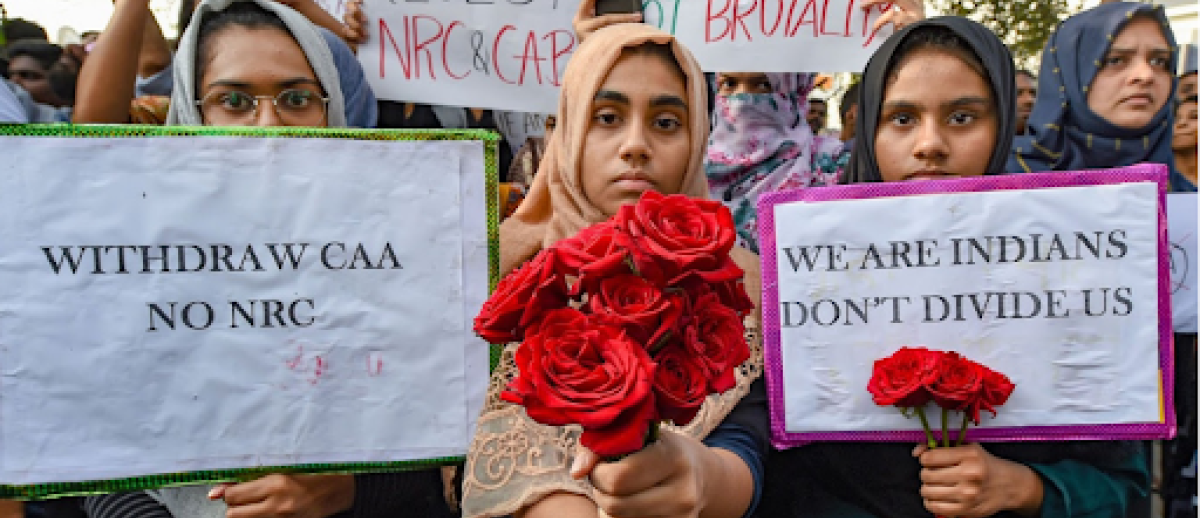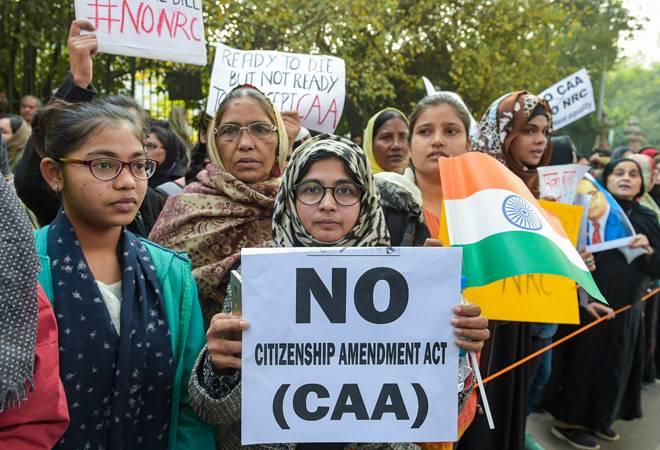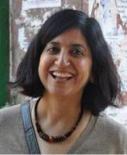State, Patriarchy, and Muslim Women in India: A Historical Perspective on the Anti-CAA Protests
archive


Protestors hold placards and roses during a demonstration against the Citizenship Amendment Act (CAA), in Chennai, India.
State, Patriarchy, and Muslim Women in India: A Historical Perspective on the Anti-CAA Protests
Even as the Right-wing Bhartiya Janata Party (BJP) government seeks to transform the Indian state to reflect its Hindu-majoritarian mien and establish unassailable power under Narendra Modi, it has faced severe challenges since returning power in 2019. Last year it was the government’s Citizenship Amendment Act (CAA) along with its adamance to implement the National Register of Citizens (NRC) that saw a turnout of angry citizens in Delhi and elsewhere. They stayed on the streets for three months, in the cold, challenging the law that attempted to recalibrate citizenship on the basis of religion. This winter, in the midst of the pandemic, the farmers have assembled on Delhi’s borders to protest hastily passed farm laws. In both cases the government has adopted similar tactics—managing media and calling the agitators anti-national, leftists, and foreign agents. These protests demonstrate that collective action is salient, agglomerating affirmative citizenship beneath the right to protest and exposing the government as arrogant, unresponsive, and in thrall of its electoral power. The anti-CAA movement saw ordinary people, particularly Muslim women, lead from the front. This article underlines the paradox of the enormous power of the BJP government built on electoral victories and the simmering discontent against its unabashed pro-Hindu politics by understanding the role of Muslim women in the anti-CAA protests from a historical perspective, emphasizing the importance of their effectively articulated and publicly performed citizenship.
A Patriarchal Pattern
Before initiating a discussion on Muslim women, the patriarchal form of the Indian (and Pakistani) state at the foundational moment of independence should be noted. During the genocidal 1947 “Partition riots” that pitted Hindu (and Sikh) mobs against Muslim ones, each targeted women of the “other” community through racialized sexual violence that saw many women raped, abducted, and branded. As the two states sought to recover “their” abducted women, ownership claims over them were made based on religion (Hindu/Sikh to India; Muslim to Pakistan).1 These “repatriations” were undertaken without the consent of the women, thereby establishing patriarchal state control over them and jeopardizing the notion of equality of citizenship. The women’s bodies, their perceived “purity/impurity,” and their belonging and non-belonging came to be signifiers of the patriarchal power of the state. This falls on a continuum with the attitude of nineteenth century upper-caste, middle-class cultural nationalists, who invested prestige in the disciplined and “tradition-bound” bodies of women as restorative of their patriarchal-political power.2
From the nineteenth century on, Muslim men also turned to upper-class sharif women to reorganize their lives and reconstruct notions of sharafat and respectability. The lessons in thrifty domesticity and reform, conveyed through novels of Nazir Ahmad and Altaf Hussain Hali3 or through journalistic outpourings in Tehzib-i-Niswan or Ismat,4 showed ambitions targeting the “Islamization” of women.5 This project involved educating women, though the ends could range from making women adept religious scholars to learning rudimentary 3Rs to read the Koran or do domestic account-keeping.6 While many elite women participated in this exercise, the majority of poor Muslim women remained outside the ambit of such reformism.7
By the early twentieth century, the Muslim as a demographic category was being viewed as a diminished citizen of the future Indian nation, transmogrifying them into the hyphenated “Indian-Muslim” we are familiar with today.8 The deprivations of Muslim communities in India were brought to general notice through the 2006 Sachar Committee Report, which underscored the many ways in which the Muslims remained “backward”: from low levels of education to virtual invisibility in high-status professions like the elite government services.9 The findings of the Muslim Women’s Survey undertaken by academics Zoya Hasan and Ritu Menon demonstrated that the disadvantages of Muslim women were based both on their community and their gender.10
By the early twentieth century, the Muslim as a demographic category was being viewed as a diminished citizen of the future Indian nation...
Despite the effort of some academics to shift the focus away from issues specific to the Muslim community such as purdah (seclusion) and Muslim Personal Law, the 1985 Shah Bano case brought the focus back to the “backward” Muslim community that used Personal Laws to suppress even small, secular gains of Muslim women.11 When Shah Bano, a middle-aged mother of five, divorced by her husband of 43 years and was able to secure from the Supreme Court a small maintenance in accordance with Article 125 of the Criminal Penal Code (Prevention of Vagrancy and Destitution), all hell broke loose. The “secular” Congress Party government under Prime Minister Rajiv Gandhi deployed its majority in the Parliament to pass the Muslim Women (Protection of Rights on Divorce) Bill 1986, succumbing to the campaign of conservative men against an ostensible breach of shari`ah provisions.12 Not only did the government abandon Muslim women, it also opened itself to the charge of Muslim “appeasement,” a slogan used by India’s Right to embarrass the Congress Party. More importantly, state-supported patriarchal power reaffirmed its hold on Muslim women’s lives.
Resistance since 2019
This context explicates the apparently beatific attitude of the BJP government when, in 2019, it used its majority in the Parliament to pass the Muslim Women (Protection of Rights on Marriage) Bill, referred to as the Triple Talaq Bill. In an attempt to protect Muslim women from Muslim men, the law not only made talaq-i-bidat (a husband saying/texting “talaq” thrice to divorce his wife) illegal and unconstitutional, but also criminalized it by making provisions to imprison men for up to three years if they took recourse to it.13 Two aspects of the circumstances of the law’s enactment are significant. Firstly, the government managed to garner support of some Muslim women to buttress their case.14 Secondly, the record of the BJP government between 2014 and 2019 actively alienated Muslim citizenry, with the government seemingly acquiescing in the lynching of Muslim men by cow vigilantes who portrayed Muslims as cow killers/consumers. The electoral success of the BJP in 2019 unleashed laws that alienated Muslims: Triple Talaq, the abrogation of Article 370 that gave special constitutional status to the Muslim majority state of Jammu & Kashmir, and the CAA itself which sought to ease the granting of citizenship to Hindus, Sikhs, Buddhists, Jains, Christians, and Parsis from Pakistan, Afghanistan and Bangladesh, excluding only Muslims from the state’s largess.

That only the Muslim majority neighboring states were selected for facilitating Indian citizenship of their discriminated minorities while excluding a state like Myanmar where the Rohingya Muslims have suffered genocidal violence, or that minorities like the Ahmadiyya of Pakistan were not considered, uncovers the Hindu Right’s intention of using the law for domestic politics, making India’s 195 million Muslims second-class citizens. Certainly, easing citizenship conditions for those looking to India for succor is a noble move, but it is the exclusionary aspect of the Act that makes it suspect. The bogey of Bangladeshi illegal migrants (called “termites” by the Indian Home Minister Amit Shah) was seen as a façade covering more nefarious designs. The further threat of NRC, which would demand proof of citizenship through often unavailable documents (given the history of India’s Partition and migration) yet allowing Hindus without documents to be brought back via the CAA, created apprehension of loss of citizenship for many Muslims.15 This is what drove the Delhi protests in the winter of 2019, spearheaded by students and overtaken by Muslim women congregated at Shaheen Bagh. From old grandmothers to ordinary housewives, women asserted their identity as nationalists and Muslims, as they read passages from the Indian constitution and held national flags.16
Certainly, easing citizenship conditions for those looking to India for succor is a noble move, but it is the exclusionary aspect of the Act that makes it suspect.
The significance of women’s participation at the intersections of religion, class, and gender cannot be overstated. Coming from Muslim ghettoes of lower-middle class Delhi, and enthusing Indian secular-liberal elites to mingle with them, the Muslim women held their own. The looming fear of becoming non-citizens made them vocal and assertive. Seen historically to be silent and invisible, unlike their elite sisters, the ordinary Muslim woman was mostly represented by someone else—whether by governments or men, including those who issued fatwas (legal pronouncements) and managed Personal Law and Waqf (Endowment) Boards. Ironically, the Modi government that had “benevolently” bestowed the Triple Talaq ban gift on “Muslim sisters” felt unsettled by their ability to act autonomously. They denied women’s subjectivity by charging them with demonstrating at the behest of their men, and quickly abandoned their sham pro-Muslim-women attitude. Amit Shah urged people to vote the BJP to power in the upcoming February Delhi state elections (which the BJP lost comprehensively), asking them to press the BJP party symbol hard when voting so as to send a message to the women gathered at Shaheen Bagh.
Eventually the manufactured Delhi riots were brought to an end.17 The COVID-19 pandemic was part of the reason, but Muslim majority localities and mosques were targeted and Muslim men were tortured into singing the national anthem as they lay injured and dying. And while the government did not concede to any of the demands of the women of Shaheen Bagh, it has not acted upon the CAA either. The stalemate stands for the moment. The government, in the meanwhile, has the larger and more troubling situation of farmers’ issues to deal with. Will it bend in the new season of protest? Only time will tell.
1. Veena Das, ““National Honour and Practical Kinship: Of Unwanted Women and Children,” in her Critical Events: An Anthropological Perspective on Contemporary India, Delhi: Oxford University Press, 1996, pp. 55-83; Urvashi Butalia, The Other Side of Silence: Voices from the Partition of India, New Delhi: Penguin, 1998; Ritu Menon and Kamla Bhasin, Borders and Boundaries: Women in India’s Partition, New Delhi: Kali for Women, 1999.
2. Tanika Sarkar, Hindu Wife, Hindu Nation: Community, Religion and Nationalism, New Delhi: Permanent Black, 2001.
3. C.M. Naim, “Prize-Winning Adab: A Study of Five Urdu Books Written in Response to the Allahabad Government Gazette Notification,” in Sumit Sarkar and Tanika Sarkar, eds, Women and Social Reform in Modern India, Ranikhet: Permanent Black, 2008.
4. Gail Minault, Secluded Scholars: Women’s Education and Social Reform in Colonial India, Delhi: Oxford University Press, 1998.
5. Faisal Devji, “Gender and the Politics of Space: The Movement for Women’s Reform,” in Sumit Sarkar and Tanika Sarkar, eds, Women and Social Reform in Modern India, Ranikhet: Permanent Black, 2008.
6. Barbara D. Metcalf, Perfecting Women: Maulana Ashraf Ali Thanawi’s Bihishti Zewar, Berkeley: University of California Press, 1992.
7. Mahua Sarkar, Visible Histories, Disappearing Women: Producing Muslim Womanhood in Late Colonial Bengal, Durham: Duke University Press, 2008.
8. The upper caste Hindu male was the subjective Indian citizen. Partha Chatterjee, The Nation and its Fragments: Colonial and Post-colonial Histories, Princeton: University of Princeton Press, 1993.
9. Anees Chishti, “Sachar Committee Report: Review,” Mainstream Weekly, Vol. XLV, No. 1, 2007.
10. Zoya Hasan and Ritu Menon, Unequal Citizens: A Study of Muslim Women in India, New Delhi: Oxford University Press, 2004. Though Hasan and Menon posited that exclusive focus on the Muslim community obfuscated the multiple reasons for the deprivations of Muslim women, the focus of their study highlighted the double-burden they bore.
11. The Muslim Personal Laws pertain to issues of marriage, divorce, inheritance, adoption, guardianship, etc.
12. Zakia Pathak and Rajeshwari Sundar Rajan, “Shahbano,” Signs, Vol. 14, No. 3, 1989, pp. 558-582.
13. Razia Patel, “Instead of a Separate Law on Triple Talaq, Centre should have Framed a Just Law for All,” Indian Express, 14 August 2019.
14. For example, Bhartiya Muslim Mahila Andolan’s Zakia Soman, or that a woman like Shayara Bano had gone to court to protest against the Triple Talaq provisions.
15. Niraja Gopal Jayal, “Faith-Based Citizenship: The Dangerous Path India is Choosing,” The India Forum, 1 November 2019.
16. The embracing of nationalist symbols by Muslim women was particularly embarrassing for the BJP that projects itself as nationalistic par excellence.
17. The riots took place between 23rd – 29th February 2019.



